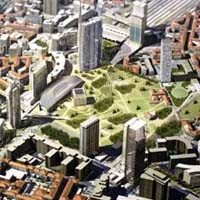Territory management and great transformations in the city region of Milan
Abstract
This study analyses the great transformations under way in the “city region” of Milan, investigating instruments, strategies and policies pursued. The meaning of “city region” is a territory formed of multidirectional relations, without hierarchic relations between center and outskirt, unlike the metropolitan area that is defined by relations of dependency (economic, social and functional) of the suburban built-up area on the main city. The city region of Milan is one of the most active and productive centers at national and European level, even so this territory has a low urban and environmental quality and it is characterized by polarization and social fragmentation raising cases that have negative reverberations on development opportunity of the area. Latest planning instruments of the area aim to territorial cohesion, attempting to design a new shape for the fragmented territory, improving the city region polycentrism, promoting the identification of intermediate city aggregations. Forms of coordinated government becomes fundamental to achieve urban and environmental redevelopment. The processes of transformation in the last years in the “city region” of Milan have confirmed the historical guiding of the territorial development, but the more important participations in existence and in realization, have widened the role and the weight of the aces North - West (Bovisa) and North (Bicocca, Ansaldo, Falck) respect to other city aces. The weight of the northern areas have been strengthened from the widening of the airport of Malpensa and from the “high speed” in the Central Station. During the last years some meaningful signs of resumption have been in the urban field. The transformation, the recovery and the valorization of the city territory project Milan towards a new urban order, typical of modern great city. The study analyzes the withins of participation and the strategies that serve to increase the inhabited offer, to improve the services publics, to define a new system of transports and green areas. Special attention is given to the mobility matter that needs strategies aiming to solve traffic congestion troubles not regarding only the zoning driven effect but also regarding its causes. Management instruments and procedures are needed to reach a dynamic balance between traffic flows attracted by local activities and traffic flows sustainable for existing transportation infrastructures. It's good to point out that traditional urban and land planning instruments are supported by “strategic planning”. Both “Provincia di Milano” and municipality aim to improve urban and environmental quality of the city region of Milan. In brief, the study aims to outline a scenery of territorial transformation under way, considering criticality and potentiality and, contextually, it aims to verify the opportunity to convert urban policy objectives in operative actions.Downloads

Copyright (c) 2014 Tema. Journal of Land Use, Mobility and Environment

This work is licensed under a Creative Commons Attribution 4.0 International License.
Authors who publish in this journal agree to the following:
1. Authors retain the rights to their work and give in to the journal the right of first publication of the work simultaneously licensed under a Creative Commons License - Attribution that allows others to share the work indicating the authorship and the initial publication in this journal.
2. Authors can adhere to other agreements of non-exclusive license for the distribution of the published version of the work (ex. To deposit it in an institutional repository or to publish it in a monography), provided to indicate that the document was first published in this journal.
3. Authors can distribute their work online (ex. In institutional repositories or in their website) prior to and during the submission process, as it can lead to productive exchanges and it can increase the quotations of the published work (See The Effect of Open Access)
